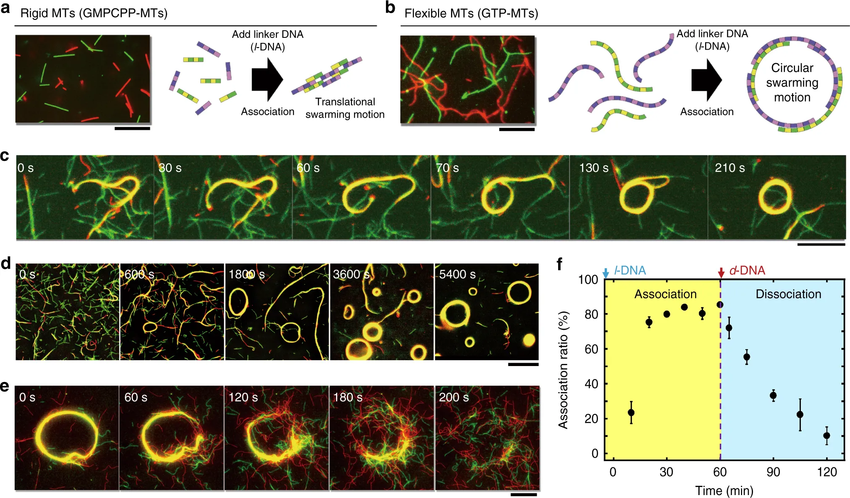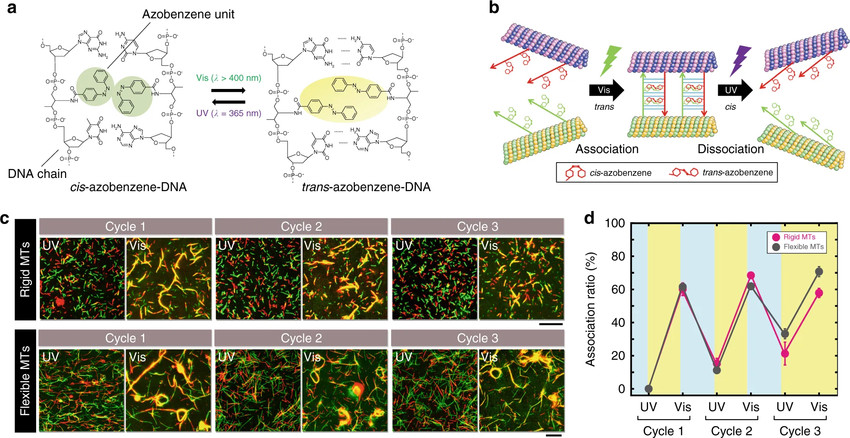Biomolecular Swarming Agents
DNA-assisted swarm control in a biomolecular motor system
Abstract
In nature, swarming behavior has evolved repeatedly among motile organisms because it confers a variety of beneficial emergent properties. These include improved information gathering, protection from predators, and resource utilization. Some organisms, e.g., locusts, switch between solitary and swarm behavior in response to external stimuli. Aspects of swarming behavior have been demonstrated for motile supramolecular systems composed of biomolecular motors and cytoskeletal filaments, where cross-linkers induce large scale organization. The capabilities of such supramolecular systems may be further extended if the swarming behavior can be programmed and controlled. Here, we demonstrate that the swarming of DNA-functionalized microtubules (MTs) propelled by surface-adhered kinesin motors can be programmed and reversibly regulated by DNA signals. Emergent swarm behavior, such as translational and circular motion, can be selected by tuning the MT stiffness. Photoresponsive DNA containing azobenzene groups enables switching between solitary and swarm behavior in response to stimulation with visible or ultraviolet light.
Overview
This study was motivated by the complex, emergent behavior that can be observed in nature through many examples of swarming creatures, such as ants, locusts, and fish schools. The self assembly properties of various components are explored, components such as Microtubules(MTs), kinesin molecular motors (which translate ATP chemical energy into translational mechanical movement), and DNA origami cross-linkers which bind MTs to one another [1]. The authors describe how the swarming behavior of the molecular agents may be regulated by tuning specific properties of the MTs in the swarm, and further how swarming behavior may be controlled via light with the addition of a photoresponsive residue imbued into the DNA cross-linker strands.
Results
The authors have previously reported in [2] how the swarming behavior of kinesin propelled MTs is affected by the rigidity of the MTs themselves, with a more rigid MT resulting in forward translational movement and less rigid MTs producing circular or vortex swarming patterns. This paper utilized these differences to enable different swarming behavior among MTs. MTs do not interact with one another in the presence of ATP, only the addition of the partially complementary DNA origami cross-linkers allows them to connect to one another and exhibit dynamic behavior. Swarmed MTs moved with up to 85% of the speed of unbound kinesin propelled MTs. Swarms could be disbanded by the further addition of a dissociating single stranded DNA (SSDNA) itself bound to the DNA origami cross-linkers, decoupling the MTs that the cross-linker was binding. In order to explore more complex behavior, the authors demonstrated how one could use SSDNA to encode logic gates into the behavior of the swarm. They gave an example of an encoded OR and AND gate, wherein swarming behavior was only observed in the presence of either one of two predesignated SSDNA strands for an OR gate, and the same behavior observed only when both predesignated were present in solution for the corresponding AND gate.

Finally, the authors demonstrated that the addition of a photoresponsive element to the SSNDA components allowed for a reusable light activated on/off switch, triggered by the alteration of the SSDNA's melting point in the presence of either UV or visible light. The behavior and efficacy of repeated switches can be seen in the figure below.

Further Work
The authors expanded upon this work in [3] to explore how one might use kinesin propelled MT actors to compute solutions to hard problems in parallel, encoding the structure of the problem into channels on a substrate via lithography.
References
- ↑ 1.0 1.1 1.2
Keya, Jakia Jannat, Suzuki, Ryuhei, Kabir, Arif Md Rashedul, Inoue, Daisuke, Asanuma, Hiroyuki, Sada, Kazuki, Hess, Henry, Kuzuya, Akinori, Kakugo, Akira - DNA-assisted swarm control in a biomolecular motor system
- Nature communications 9(1):453,2018
- BibtexAuthor : Keya, Jakia Jannat, Suzuki, Ryuhei, Kabir, Arif Md Rashedul, Inoue, Daisuke, Asanuma, Hiroyuki, Sada, Kazuki, Hess, Henry, Kuzuya, Akinori, Kakugo, Akira
Title : DNA-assisted swarm control in a biomolecular motor system
In : Nature communications -
Address :
Date : 2018
- ↑
Wada, Shoki, Kabir, Arif Md Rashedul, Ito, Masaki, Inoue, Daisuke, Sada, Kazuki, Kakugo, Akira - Effect of length and rigidity of microtubules on the size of ring-shaped assemblies obtained through active self-organization
- Soft Matter 11(6):1151--1157,2015
- BibtexAuthor : Wada, Shoki, Kabir, Arif Md Rashedul, Ito, Masaki, Inoue, Daisuke, Sada, Kazuki, Kakugo, Akira
Title : Effect of length and rigidity of microtubules on the size of ring-shaped assemblies obtained through active self-organization
In : Soft Matter -
Address :
Date : 2015
- ↑
Nicolau, Dan V, Lard, Mercy, Korten, Till, van Delft, Falco CMJM, Persson, Malin, Bengtsson, Elina, M{\aa}nsson, Alf, Diez, Stefan, Linke, Heiner - Parallel computation with molecular-motor-propelled agents in nanofabricated networks
- Proceedings of the National Academy of Sciences 113(10):2591--2596,2016
- BibtexAuthor : Nicolau, Dan V, Lard, Mercy, Korten, Till, van Delft, Falco CMJM, Persson, Malin, Bengtsson, Elina, M{\aa}nsson, Alf, Diez, Stefan, Linke, Heiner
Title : Parallel computation with molecular-motor-propelled agents in nanofabricated networks
In : Proceedings of the National Academy of Sciences -
Address :
Date : 2016